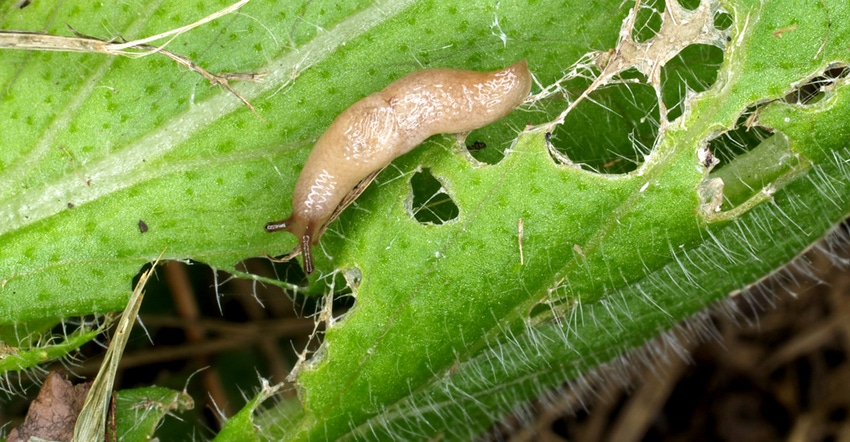May 6, 2022

How do you manage damage by slugs in the garden and yard? While slugs may appear like a harmless visitor to one’s landscape or garden, they can actually become destructive pests to some of our favorite herbaceous plants in the farmyard, including hosta, marigolds, roses, strawberries and more.
Like caterpillars, slugs damage plants by chewing and consuming leaves and flowers. Using their rasping tongues, slugs scrape irregular-shaped holes with characteristic smooth edges. Gardeners are often left perplexed when they visit their plants and see damage, but no obvious culprit.
This is because slugs are nocturnal in nature, actively eating at night and hiding away during daylight hours. If you suspect damage to your plants is because of slug feeding, carefully examine leaves for trails of mucus or look for slugs in the nearby landscape.
As with any integrated pest management plan, confirming the identity of the pest is an important first step that helps us better understand the pest’s biology and guide our management decisions. For example, knowing exactly where the slugs hide is key to controlling them and preventing further damage.
Slugs often escape the heat of the day by hiding under stones, boards and debris, and within dense ground cover. Eliminating these possible harborage areas and reducing the amount of moisture in the landscape makes the habitat less favorable to slugs. Consider only watering early in the morning to allow time for excess water to dry out, or switch to drip irrigation.
Control tactics
While altering the habitat is an effective way to prevent slugs from invading your garden, a variety of physical and chemical control tactics can be used to further manage populations of slugs that are already present. Larger slugs can easily be hand-picked off plants and from nearby areas.
Additionally, slugs are relatively easy to trap through the lure of dark and moist hiding places. Simply lay down boards or damp newspaper throughout the garden and landscape, and dispose of any slugs that have accumulated underneath the traps overnight. This should be done on a daily basis until the population has noticeably declined.
Some gardeners have even found beer to be an effective lure — simply place the beer in a shallow dish or pan to trap and drown slugs that are attracted to the fermented product.
As a last resort, several chemical baits are available for use. Common active ingredients in slug baits include iron phosphate, ferric sodium EDTA and metaldehyde. When choosing a pesticide, always read and carefully follow label warnings and directions before use. Products containing metaldehyde are particularly poisonous to people and other animals and should be only used in areas where exposure to children and pets is limited.
To be effective, baits should be placed in the soil near plants susceptible to slug feeding and in areas that slugs may frequent or hide. For more information on slugs and their management, contact your local Nebraska Extension office.
Chapman is a Nebraska Extension urban entomology educator in Lancaster County.
You May Also Like




